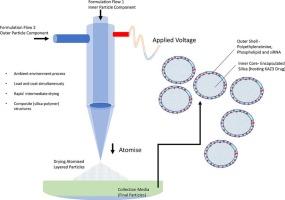新型电喷涂核壳聚乙烯亚胺和磷脂包被msn,用于共同递送KAZ3和MDR-1 siRNA,用于多药耐药结肠癌的有效化疗。
IF 4.3
2区 医学
Q1 PHARMACOLOGY & PHARMACY
European Journal of Pharmaceutics and Biopharmaceutics
Pub Date : 2025-08-13
DOI:10.1016/j.ejpb.2025.114838
引用次数: 0
摘要
为了提高化疗药物的生物利用度和解决获得性多药耐药(MDR)问题,人们采用了不同的策略和多功能纳米载体,从而确保化疗效率和不良反应的减少。其中,介孔二氧化硅纳米颗粒(MSNs)是令人兴奋的基质,可以提高细胞毒性药物的生物利用度,并通过其抗癌药物和短干扰RNA (siRNA)的共同递送潜力来规避耐多药。在本研究中,用(1:1)聚乙烯亚胺(PEI)和磷脂(PL)复合材料包覆msn,并采用同轴电喷涂一步法负载抗癌查尔酮(KAZ3)。利用这种新型的递送系统将MDR-1 siRNA和KAZ3共同递送到结肠癌细胞系,以敲低MDR-1基因,从而提高KAZ3的细胞毒性。采用SEM、荧光显微镜、TGA、zeta粒度、活性物质(KAZ3和siRNA)的装载效率、活性物质释放研究、siRNA凝胶阻滞和活性物质的细胞摄取等手段对制备的药物/siRNA递送体系进行了表征。还使用MTT法评估了制剂对癌细胞系(HCT 116)的细胞毒性,并使用western blotting法评估了MDR-1基因沉默效率。结果表明,同轴电喷涂可有效制备核壳包被的msn,该msn能够同时向结肠癌细胞系递送MDR-1 siRNA和KAZ3。用PL和2.5 KDa PEI包被的msn比25KDa PEI包被的msn与人体细胞的相容性更好。KAZ3/siRNA负载PEI-PL包被的msn成功地将多药耐药基因表达降低到40% %,并导致高达92% %的结肠癌细胞死亡。本研究的结果表明,电流体动力雾化(EHDA)作为一种生产载药MSNs基核壳粒子的技术具有巨大的潜力。本文章由计算机程序翻译,如有差异,请以英文原文为准。

Novel electrosprayed core-shell polyethyleneimine and phospholipid coated MSNs for Co-delivery of KAZ3 and MDR-1 siRNA for efficient chemotherapy in multidrug-resistant colon cancer
Different strategies and multifunctional nano-carriers have been employed to enhance chemotherapeutic drugs bioavailability and tackle acquired multi-drug resistance (MDR) thus ensuring efficient chemotherapy with fewer adverse effects. Among these, mesoporous Silica Nanoparticles (MSNs) are exciting matrices for improving cytotoxic drugs bioavailability and circumventing MDR through its potential of co-delivery of anticancer agents and short interfering RNA (siRNA).
In this study, MSNs were coated with (1:1) Polyethyleneimine (PEI) and phospholipids (PL) composite and were loaded with KAZ3 (Anticancer chalcone) using coaxial electrospraying in a one step process. The novel delivery system was used to co-deliver both MDR-1 siRNA and KAZ3 to colon cancer cell lines in order to knockdown the MDR-1 gene and thus to improve KAZ3 cytotoxicity. The prepared drug/siRNA delivery system was characterized using SEM, fluorescence microscopy, TGA, zeta sizer, actives (KAZ3 and siRNA) loading efficiency, actives release studies, siRNA gel retardation and actives cellular uptake. The cytotoxicity of formulations against cancer cell lines (HCT 116) was also assessed using MTT assay and MDR-1 gene silencing efficiency using western blotting. Results showed that coaxial electrospraying was efficient in preparing core–shell coated MSNs that were able to co-deliver both MDR-1 siRNA and KAZ3 to colon cancer lines. The MSNs coated with PL and 2.5 KDa PEI were found to be more compatible with human cells than to 25KDa PEI coated MSNs. KAZ3/siRNA loaded PEI-PL coated MSNs were successful in decreasing multidrug resistance gene expression to 40 % and causing up to 92 % colon cancer cell death. The findings of the present study show the immense potential of electro-hydrodynamic atomization (EHDA) as a technique for producing drug loaded MSNs based core–shell particles.
求助全文
通过发布文献求助,成功后即可免费获取论文全文。
去求助
来源期刊
CiteScore
8.80
自引率
4.10%
发文量
211
审稿时长
36 days
期刊介绍:
The European Journal of Pharmaceutics and Biopharmaceutics provides a medium for the publication of novel, innovative and hypothesis-driven research from the areas of Pharmaceutics and Biopharmaceutics.
Topics covered include for example:
Design and development of drug delivery systems for pharmaceuticals and biopharmaceuticals (small molecules, proteins, nucleic acids)
Aspects of manufacturing process design
Biomedical aspects of drug product design
Strategies and formulations for controlled drug transport across biological barriers
Physicochemical aspects of drug product development
Novel excipients for drug product design
Drug delivery and controlled release systems for systemic and local applications
Nanomaterials for therapeutic and diagnostic purposes
Advanced therapy medicinal products
Medical devices supporting a distinct pharmacological effect.

 求助内容:
求助内容: 应助结果提醒方式:
应助结果提醒方式:


